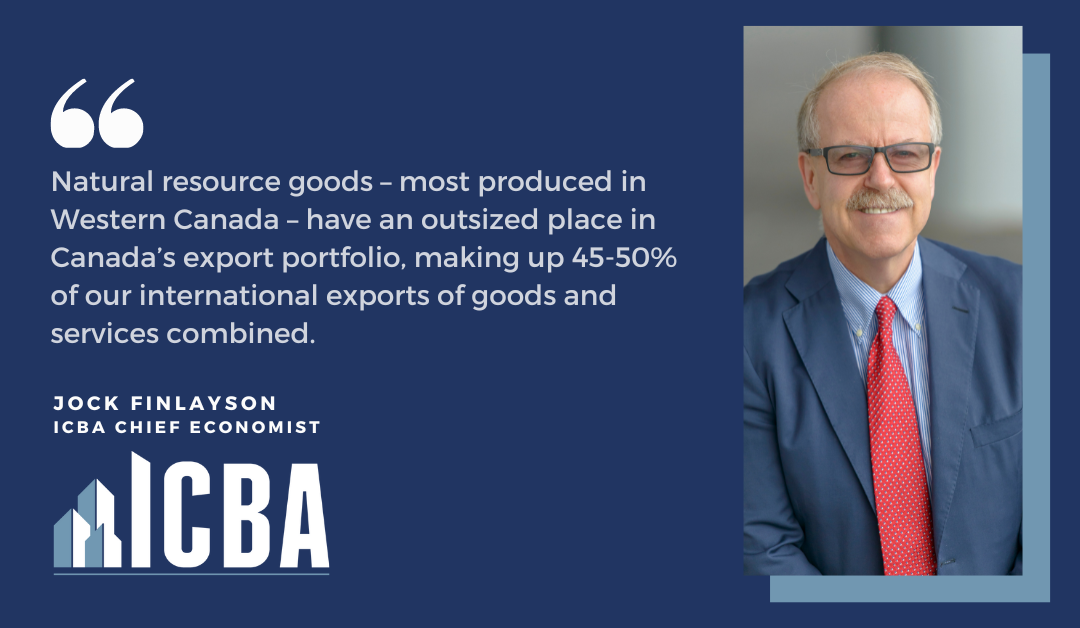By Jock Finlayson, ICBA Chief Economist
Canada is a mid-sized economy that relies heavily on trade in goods and services to sustain our still high standard of living. Exports support jobs and provide external sources of income that circulate throughout the economy, providing income for exporting businesses, their employees and suppliers — as well as for governments. Ultimately, exports furnish the means to pay for the imports that Canadian consumers want and value. The ability to import also enables Canadian businesses to access foreign-produced parts, components, intellectual property, and other forms of advanced technology.
The basket of goods and services that a market-based economy sells abroad provides important clues as to the activities and lines of business in which it enjoys a “comparative advantage.” As summarized by the New Palgrave Dictionary of Economics, the principle of comparative advantage “is the fundamental analytical explanation of the source of…gains from trade.” It captures the idea that countries and regions engaged in trade benefit the most when they specialize in exporting goods and services of which they are relatively efficient producers.
A look at the data on Canada’s two-way trade in goods and services helps us understand where our country enjoys comparative advantage. The accompanying figure shows Canada’s exports minus imports, known as the balance of trade, in major sectors, combined over the two-year period 2022-2023. A few highlights emerge from the figure.
 The first is that natural resource goods – most produced in Western Canada — have an outsized place in Canada’s export portfolio, making up 45-50% of our international exports of goods and services combined. They are also the only categories of traded products – apart from aerospace – where Canada reliably racks up trade surpluses.
The first is that natural resource goods – most produced in Western Canada — have an outsized place in Canada’s export portfolio, making up 45-50% of our international exports of goods and services combined. They are also the only categories of traded products – apart from aerospace – where Canada reliably racks up trade surpluses.
The second key point concerns the role of energy. Energy products account for more than a quarter of Canada’s international merchandise exports. Within the broad energy basket, oil, oil-based products, and natural gas dominate, providing around 80-85 per cent of total energy-based export revenues. Over 2022-23, energy produced an aggregate trade surplus of almost $300 billion, a figure that far surpasses the combined surpluses recorded across all other industries.
Energy’s contribution to Canada’s exports is set to increase over the next several years. The principal reason is the looming start-up of liquefied natural gas (LNG) production in British Columbia, along with the rising volumes of Western Canadian oil now being shipped following the completion of pipeline expansion projects. Far from quickly transitioning away from traditional energy products — a false claim frequently made by ministers in the Trudeau government – the truth is that Canada is becoming more reliant on the energy sector to deliver export earnings.
The table also shows that Canada runs large and persistent trade deficits in most non-resource categories, notably consumer goods, electrical and electronic products, and industrial machinery and equipment. We also incur sizable trade deficits in motor vehicles and parts, despite being a significant producer of such products; the reason is that the value of vehicle and parts imports greatly exceeds the value of Canada’s exports of these items.
The fact that Canada regularly posts trade surpluses across all of the various segments of the natural resource economy confirms that these are the main industries in which our country has a global comparative advantage. Some politicians are uncomfortable with this fact and prefer to talk up opportunities to build other industries. There is nothing wrong with working to diversify Canada’s economy and export portfolio. The sensible way to do this is to establish conditions that allow such industries to grow in Canada over time. That does not justify governments ignoring or imposing ever-greater regulatory and policy burdens on our energy and other natural resource sectors, which continue to make an outsized contribution to paying Canada’s bills.

